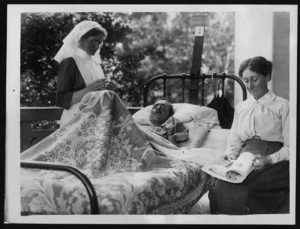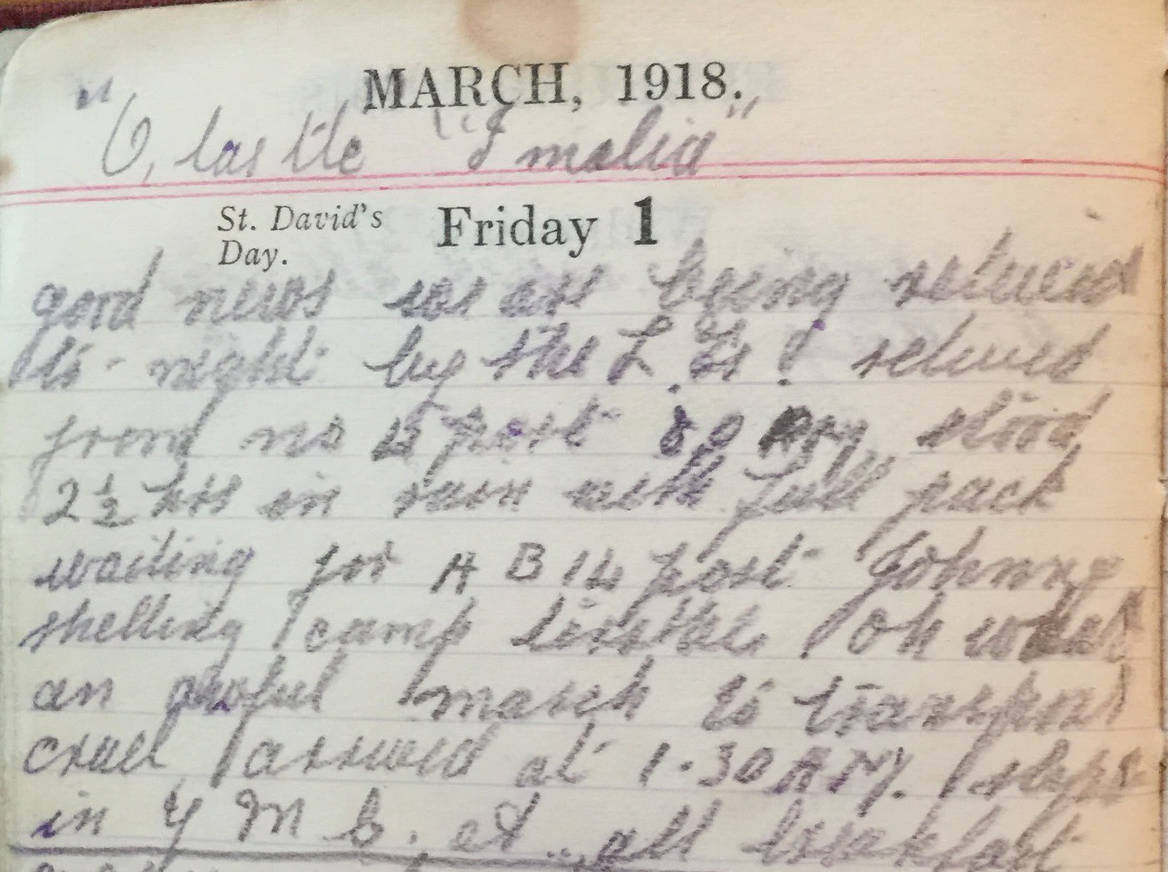Friday March 1st, 1918
‘O, Castle Imalia’
Good news. We are being relieved tonight by the Lancashire Fusiliers and relieved from number 15 post 8pm. Stood two and a half hours in rain with full pack, waiting for AB14 post. Johnny shelling camp terrible. Oh what an awful march to transport – cruel. Arrived at 1:30am and slept in YMCA.
O Castle Imalia!
Unfortunately we haven’t been able to figure out to what this is referring. However somehow the phrase still conveys the joy that Frank feels on hearing that they are to be relieved on the front lines by 12th Battalion, Lancashire Fusiliers. Nor do we know to what ‘number 15 post’ is referring or even if it is ’15’. Any ideas for either, please share as a comment.
The march away from the lines though, starting late at night until the early hours, was clearly unappreciated by Frank. However the Battalion makes it to Rates without incident and the men are billeted in the YMCA for the rest of the night.
Young Mens Christian Association (YMCA)

The YMCA was formed in London in 1844 by a 22 year old, George Williams. The US YMCA was started in New England in 1851. It was the US YMCA that first helped during war time when it provided 5000 volunteers to ease the suffering of troops during the Civil War. The YMCA has been supporting British troops both at the front and at home since the Boer War (1899-1902).
Within days of the outbreak of WWI the YMCA had established 250 ‘huts’ attached to army camps and at transport hubs across the UK. By the end of 1917, they had 1500 locations in the UK, 500 huts on the British lines in France and Flanders, and over 200 huts on other fronts, including 42 in Salonika and the Mediterranean.

As reported in The Manchester Guardian¹ on November 10th, 1917 ‘At every stopping-space in the soldier’s long circle from civilian to civilian again, there is one of those cosy brown huts which means so much as a link with humanity.’
Their care also extended to hostels and meals for women working in support of the war effort, especially munitions. This was described in wonderful detail by the writer John Galsworthy in The Manchester Guardian in December 1917. The YMCA also provided assistance to families visiting the wounded or war graves in France as depicted in this photograph.
The YMCA were not alone. The Church Army, the Salvation Army and others all provided services and succour to the troops, their relatives and those working on the home front. The care of the nation knew few bounds.
Tonight Frank enjoys the comfort of one of the ‘cosy brown huts’ in Rates.
13th (Service) Battalion War Diary – 1st March 1918 – No 1 Sector, Minden Camp
Our artillery was active on the following points: O2 Pillbox. trenches west of Hill 340 and other usual points. Enemy artillery was active on Rockley and the usual battery positions. About 17:00 hours he fired about twelve shrapnel on No 1 Sector Trenches and Wylye Camp. Between 16:30 and 17:20 hour enemy Trench Mortar shells fell. 4 (heavy) on Dojran Road Camp, 12 ditto on ST B2 and ST B4 and 3 on ST B6. Fresh enemy work was noticed on O1, The Knot, at foot of Hill 340. Work on top of the Knot looked like a new Pillbox.
The Battalion was relieved by the 12th (S) Battalion, Lancashire Fusiliers and moved to Rates where officers were accommodated at the Rates Club and the men in the Rates Recreation Room.The relief was complete by 22:45 hours without any casualty and the Battalion reached Rates by 02:30 hours on 2-3-18. The 12th Cheshire Regiment was relieved at Pearse Ravine by the King’s Own. (For order of move see Appendix III of February 1918.) 2 OR having rejoined are again taken on from 27-3-18 and 2 OR from 28-3-18. The Battalion becomes Army Reserve.
References & Further Reading
¹ – note ‘The Manchester Guardian’, first published in 1821, evolved into ‘The Guardian’ newspaper in 1959.
‘The Y‘ on YMCA.net
‘YMCA and other voluntary organisations‘ on LongLongTrail
* images from the papers of Earl (Field Marshall) Haig, held by the National Library of Scotland



Thank you Christine!
Andonis
Hello, Caroline
You write: By the end of 1917, they had 1500 locations in the UK, 500 huts on the British lines in France and Flanders, and over 200 huts on other fronts, including 42 in Salonika and the Mediterranean.
What is the source of the information on the 42 huts of Salonika and the Mediterranean, please?
I’m trying to find out how many British YMCA huts were in the Salonika front alone.
Thank you!
Andonis, I got these facts and figures from an article or an advert for ‘YMCA Hut Week’ in The Guardian newspaper on November 8th, 1917.I remember that the advertisements seeking donations that appeared regularly in the British newspapers often provided details of this sort. You might want to look there too.
I just looked at my more detailed notes and found the following info from the Guardian on this date:
Manchester & Salford to raise (25k) (general appeal for 500k) money for a YMCA centre at Le Havre, double hut in Rouen and cinema in Dunkirk.
YMCA – support walking wounded after battle with refreshments etc (26k cups of cocoa free in an advanced dug out in 1 week; acting as host to relatives visiting wounded men in France (inc transport, board and loggings and itinerary) + hundreds of thousands of books for camps & trenches.
YMCA huts
500 in France & Flanders
60 in Egypt & Palestine
45 in India
42 in Salonika & Med (26 more needed)
47 in Mesopotamia
30 in British East Africa and Adriatic Isles
Hope this helps. I got the info on the Boer War from Katie Adie’s book about women’s roles in WWI. And other info from the book ‘The Manchester Pals’.
The article by John Galsworthy (Observer newspaper, Dec 23rd, 1917) is also worth reading about different facets of the YMCA’s work.